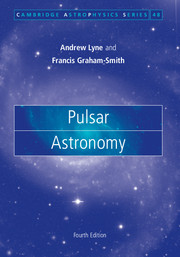Book contents
- Frontmatter
- Contents
- List of illustrations
- Preface
- 1 The discovery of pulsars
- 2 Neutron stars
- 3 Telescopes and techniques
- 4 The distances of the pulsars
- 5 Pulsar timing
- 6 Timing and astrometry of binary pulsars
- 7 Timing irregularities
- 8 The Galactic population of pulsars
- 9 The Crab and Vela Pulsars
- 10 Other young pulsars
- 11 Millisecond and binary pulsars
- 12 Accretion-powered X-ray pulsars
- 13 Magnetars
- 14 Supernovae and their remnants
- 15 Integrated pulse profiles
- 16 Individual pulses
- 17 Location of emitting regions
- 18 Radiation processes
- 19 The emission mechanisms
- 20 Interstellar scintillation and scattering
- 21 The interstellar magnetic field
- 22 Achievements and prospects
- References
- Index
21 The interstellar magnetic field
Published online by Cambridge University Press: 05 March 2012
- Frontmatter
- Contents
- List of illustrations
- Preface
- 1 The discovery of pulsars
- 2 Neutron stars
- 3 Telescopes and techniques
- 4 The distances of the pulsars
- 5 Pulsar timing
- 6 Timing and astrometry of binary pulsars
- 7 Timing irregularities
- 8 The Galactic population of pulsars
- 9 The Crab and Vela Pulsars
- 10 Other young pulsars
- 11 Millisecond and binary pulsars
- 12 Accretion-powered X-ray pulsars
- 13 Magnetars
- 14 Supernovae and their remnants
- 15 Integrated pulse profiles
- 16 Individual pulses
- 17 Location of emitting regions
- 18 Radiation processes
- 19 The emission mechanisms
- 20 Interstellar scintillation and scattering
- 21 The interstellar magnetic field
- 22 Achievements and prospects
- References
- Index
Summary
The magnetic fields which are first brought to mind in any discussion of pulsars must surely be the enormous fields at the surface of the neutron star itself. These fields are of the order of 1012 gauss (108 tesla) for most pulsars, and 108 gauss for the older, millisecond pulsars. Pulsar radio waves may, however, be used as a means of measuring the magnetic field on the line of sight to the observer; this interstellar field is, by way of extreme contrast, of order 1 to 10 microgauss. The observational link between these extremes is simple: the high field of the pulsar is responsible for the linear polarisation of the radio emission, while the Faraday rotation of the plane of polarisation in interstellar space is a measure of the interstellar magnetic field along the line of sight.
Optical and radio observations
The existence of an interstellar magnetic field was first demonstrated by the observation of the polarisation of starlight, notably by Hall & Mikesell (1950) and by Hiltner (1949). A small degree of linear polarisation was found, which was common to several stars in the same general direction. The polarisation was due to scattering in interstellar space by particles which are elongated, so that they scatter anisotropically, and which are aligned with their long axes perpendicular to the Galactic magnetic field.
- Type
- Chapter
- Information
- Pulsar Astronomy , pp. 300 - 306Publisher: Cambridge University PressPrint publication year: 2012

